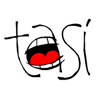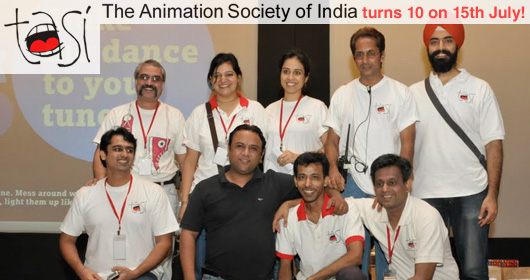A Decade of TASI
 The Animation Society of India (TASI) celebrates its 10th birthday on July 15th 2011. To commemorate 10 years of actively promoting animation in India, community building and grassroots outreach by TASI, AAA speaks to the Honorary Secretary of TASI, Ranjit Singh. Known to friends as Tony, he is also one of the founding members of the society and a key force behind its activities.
The Animation Society of India (TASI) celebrates its 10th birthday on July 15th 2011. To commemorate 10 years of actively promoting animation in India, community building and grassroots outreach by TASI, AAA speaks to the Honorary Secretary of TASI, Ranjit Singh. Known to friends as Tony, he is also one of the founding members of the society and a key force behind its activities.
AAA: 15th July 2001 to 15th July 2011 – 10 long years and one big journey. How does it feel?
Tony: Awesome, there’s a sense of personal pride in this fantastic achievement.
AAA: Tell us the story of the birth of TASI. Who were the other Founders and what inspired you all to begin this movement in India? How were the first few years?
Tony: TASI was born out of a common commitment to share knowledge within the community. Originally the idea was to form a group that would get together on a regular basis and exchange thoughts, ideas, share experiences and expertise so that the community could help itself to grow. It was formalized later into a registered trust with voluntary participation and contribution towards its management and operations as the fundamental principles. As per legal requirements we needed 8 founding members and these included myself, Kireet Khurana, Ram Mohan, Suhael Merchant, Marvin Fernandes, Mohenish Gupta, Ashwin Parulkar and E Suresh.
The first few years were difficult since people would not believe that professionals would take out time to volunteer services for a community building exercise. People thought there had to be some vested interest for forming such an organization. So there was a considerable struggle to educate and convince the skeptics.

Team TASI @ Anifest India 2010
AAA: How was the response from the Indian animation fraternity when the society was formed?
Tony: Skeptical, suspicious and most thought that this would just die a natural death as they felt that the voluntary model was fundamentally flawed. Why would anyone in their right senses do voluntary work and that too for the benefit of others?
AAA: What were the goals you’ll set for yourselves back in 2001? Do you feel like TASI has managed to achieve them? What’s the next target for the society?
Tony: Our basic goal was to reach out to any and everyone who was interested in Animation and to encourage them to be a part of the movement. A strong local community has many advantages with the biggest being that of knowledge dissipation. Mutual growth can be accelerated through sharing of knowledge and expertise. To a large extent we have achieved this goal, but there is lots to do. Over the years we have streamlined our operations, each committee member has ownership over his/her tasks and responsibilities. We have established a fantastic network across the country, our registration process is simple and straightforward. Our website is up to date and monitored regularly. Our design, logistics, operations, administration and finance and industry liaison responsibilities are clearly assigned to respective members in the committee. So we have achieved a sense of order in our functioning. We have also established a career guidance section on our website that has been created in consultation with industry experts.
The next target is to strengthen our national level presence and to initiate international collaborations with similar bodies overseas. Over the past few years, films that are nominated for the TVCA at Anifest India have been compiled by TASI and sent to various international festivals. You may be surprised to know that internationally TASI is very well known and respected as the premier community body in India.
AAA: As a not-for-profit organisation that runs completely on the enthusiasm and hard work of volunteers, including the committee members, what are the challenges that you face on a regular basis? With the recession hitting the Indian animation industry badly, has that affected TASI in its activities and the response that your events get?
Tony: The main challenge is to find people who are willing to take out time for society work. It is really hard work, believe me, it takes serious commitment and passion to be able to make time and devote to the operations of the society. Since we are a registered Trust, we have certain statutory obligations that have to be fulfilled, so we constantly are on the lookout for people who are willing to proactively take responsibilities. A lot of people want to work for TASI but only when they have time, very few people actually realize that you have to make the time and treat this at par with other commitments. We’re lucky that we’ve got a committee that shares this belief.
The recession was a big revelation for us and to what we had actually achieved. Frankly we were worried that funds would not come in from our supporters, but fortunately we were so wrong. I firmly believe that it is due to our uncompromising stand on our principle of neutrality that TASI has been able to command respect from the Industry. Kudos to our supporters who opened their hearts (and wallets!) and gave generously. This ensured that the society activities did not take a hit. In fact, the past couple of years have actually seen a spurt in the knowledge seminars organized by us across the country. See, the biggest plus point that we have is that whatever funds we generate or receive from supporters, are all put back into the community. TASI does not have any paid employees and the committee members do not get any monetary benefits, no honorarium, no fee, no salary – nothing at all. So when you give to TASI, you are assured that it will all put back into the community. When people see you doing something selflessly for the common good, they generally are very supportive.
AAA: What, in your view, is the single biggest achievement of TASI?
Tony: Grass-root penetration. TASI has reached the farthest corner of the country and students, professionals and animation enthusiasts are all connected through us.
AAA: How difficult has it been to take animation to the grassroots, especially keeping in mind the lack of awareness about the subject in our country?
Tony: Our way of reaching out is thru seminars and knowledge workshops. These require funds to organize. A single outstation event may cost the society a couple of lakhs in logistics. There are other factors such as local coordination and ground level arrangements that have to be done for every event. At times we have even refused sponsorship from companies when they insist on exploiting the situation for personal gain – like deriving some marketing mileage in lieu of their support to the Society. We want people to contribute because they see merit in community building exercises, not because they can ride TASI’s reputation for their own personal interests. It is a fact that TASI events are much sought after and the response is generally huge. So the challenge has been to organize events with local support but in keeping with the guiding principles of the society – No marketing, no sales, no promotion, no personal publicity. Thankfully there are enlightened people out there who understand and support this and this helps us to reach out to create more awareness about the subject.
One of the main headaches and frustrations is Govt / official apathy towards such community efforts. There are so many hurdles that are created and with complete disdain that would discourage even the most diehard optimist. Many times we have come across officials who have no clue and are not even interested in understanding what we are doing here. All they want is to see how they can extract their pound of flesh. At times like these you really ask yourself the question – what the hell am I doing here and for what! Khaya peeya kuch nahin, glass toda barah anna….. Which is precisely why we want to build a strong community, people sit up and listen only to those who have formidable strength in numbers.
AAA: How different was the animation scenario back in 2001 from what it is today? Are the challenges faced by animators and the industry the same? What is the most significant change that you see now?
Tony: Things were quite different back then. There weren’t many large studios employing 100’s of artists. The outsourcing business model had yet to come in. Animation was mostly the domain of small and mid size studios and most of the work concentrated around TV commercials. VFx in films was rare compared to what it is today. Indian animated features were practically non-existent. International studios had yet to come in to India. I don’t know if there were any gaming companies at that time. Animation training institutions did not exist like they do today. Heck, now that you look back it seems like the stone age!
The most significant change is the development of the Indian artist, both from the technological as well as application point of view. Indian artists are comparable to the best in the world and a lot of the really cool stuff in international projects is being done here in India by local artists. So that’s a big development.
AAA: When did TASI start Anifest India? How was the experience of the organising India’s first ever Animation Festival? Was it a 3 day event back then too? Who all were in the TASI team then?
Tony: Anifest India started in 2005. It was just an evening affair and had a turnout of 220+ people from all over the country. It was an exhausting experience since it was a first for most of us. Organising something at that scale with limited resources was a huge ask. I believe our entire budget for the event that year was less than 1.5Lakhs, which included the rent for the place – Ramada Palm Grove in Mumbai, food, refreshments for all the attendees and all other event related expenses. God alone knows how we pulled that off.
That year we had Ram Mohan, Kireet, myself, Yogi, Mohenish, Vaibhav, Anil Chopra and Sanjeev Waeerkar in the TASI team. The event was co-hosted by Asifa India and so Bill Dennis, Vani, Srirang also took on huge responsibilities. We had a team from Animation Xpress (which was still in its infancy) that helped with the arrangements as well. So it was truly a collaborative beginning.
AAA: What have you guys planned for Anifest India this year?
Tony: Our strength is in selecting topics and speakers for our events and like every year, Anifest India 2011 will have a wide variety of subjects. There is an exciting lineup that has been planned and we’re sure that all those who attend are in for another annual treat. Some of the topics are:
- Sound Design for Animation,
- IP creation, protection and monetisation,
- Conversion from 3D to 3D Stereoscopy of Delhi Safari,
- Alternate Animation – Automobile Design and Medical Animation,
- Behind the scenes of X-Men – First Class and Hop,
- Comic Art and much more.
